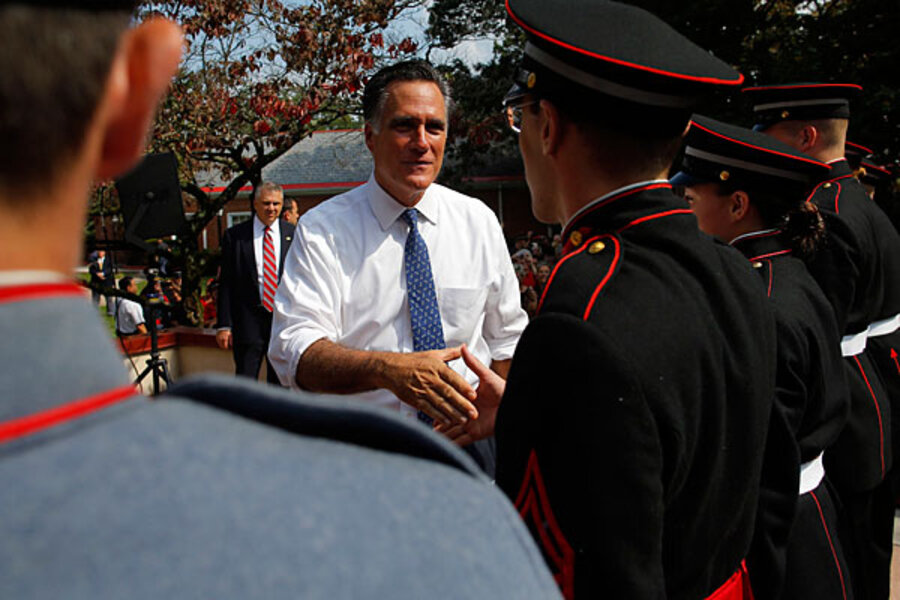Mitt Romney plans Pennsylvania ad blitz. Can he turn state red?
Loading...
| Washington
What happens when political momentum collides head-on with cold, hard polling data?
The answer could come Nov. 6 in Pennsylvania.
On Tuesday, Mitt Romney added it to its list of “target states” for the last week of the campaign, meaning he will advertise in the commonwealth on Election Day and the day prior after largely ignoring the state for months. Groups allied with Romney will spend another $3 million on ads in Pennsylvania, as well. The reason for the switch? The Romney campaign is surging, operatives say.
The Obama campaign, however, dismisses Mr. Romney’s “Big Mo” argument with a few facts: The president has led virtually every poll this election cycle, his party holds a sizable advantage in registered voters, and the Keystone State that hasn’t gone for a Republican presidential candidate since 1988.
Writ large, this argument goes beyond Pennsylvania: In states such as Minnesota, Wisconsin, and Michigan, Democrats argue that the polls are on their side, while Republicans counter that they are coming on strong when it counts. In North Carolina, the sides are reversed.
Clearly, Romney would love to win any of the states that polls have presented as blue to the core – and next week’s election could reveal how far momentum can go toward flipping polls in the latest stages of a campaign. But Romney’s Pennsylvania gambit could also represent an attempt to force Mr. Obama to play defense in a state he had hoped to take for granted.
In doing so, Romney hopes not only to move the polls in those states, but to pull Democratic resources from Ohio, Virginia, and other battleground states that Romney seemingly needs to win. Indeed, the Obama camp announced Tuesday that it would counter the $3 million spent by Romney's allies in Pennsylvania.
Rich Beeson, the Romney campaign’s political director, spoke of offense and defense in a memo released Tuesday afternoon. “This expansion of the electoral map demonstrates that Governor Romney’s momentum has jumped containment from the usual target states and has spread to deeper blue states that Chicago never anticipated defending,” he wrote.
Pennsylvania and its 20 electoral votes have long been a dream for the GOP. Sen. John McCain had grand designs for winning in 2008 – and lost by 10 points. In his first term, President George W. Bush visited the state 44 times and still lost to Sen. John Kerry in 2004.
This year, state polls have given Obama a steady mid-single digit advantage over Romney since the beginning of October. The president maintains an average lead of 5 points in the most recent quartet of polls. In fact, Romney has not led a single poll in the Keystone State since February – and has led only three of 56 polls taken in 2012.
To Democrats, the Romney plan smells of desperation. “Now, like Republicans did in 2008, they are throwing money at states where they never built an organization and have been losing for two years,” said Obama campaign manager Jim Messina in an e-mailed statement. “Let’s be very clear, the Romney campaign and its allies decision to go up with advertising in Michigan, Pennsylvania and Minnesota is a decision made out of weakness, not strength.”
Before Tuesday’s announcement, the Romney campaign signaled its slight hopes for Pennsylvania through its infrequent visits to the state. Romney’s last visit, a trip to Valley Forge on Sept. 28, was his first since July. Republican vice presidential nominee Paul Ryan and Ann Romney went in October, but only once each – and Ryan was at his rally for less than an hour.
A late Romney dive into the state, however, risks firing up labor unions and other Democratic constituencies who previously might have stayed at home, assuming the race was won.
“Poking this bear with this stick is going to wake up the sleeping beast, but it’s not going to only eat Mitt Romney, it’s going to eat a lot of other Republicans, too,” says T.J. Rooney, a former chairman of the state Democratic Party. “If there was any lethargy on the part of Democrats it’s a great call to get off the sofa and get out and do the get-out-the-vote stuff.”
Overall, Republicans point out that voter registration in Pennsylvania, at just under 8.5 million voters, is down from the 8.75 million in 2008. That’s resulted in a slight decline in Democrats’ edge, which stands at 1.1 million.
Moreover, Romney might see an opportunity to make inroads among typically Democratic voters in Pennsylvania coal country. Coal is, perhaps not so coincidentally, the subject of a new ad released by the Romney campaign Tuesday.
“The great unwritten story, that will be figured out after the election is over, is how much western Pennsylvania has abandoned the Democrats,” says Christopher Nicholas, a veteran Republican political consultant and political director at the Pennsylvania Business Council.
And while polling hasn’t shown a Romney surge, state Republicans were heartened by the performance of their Senate candidate, Tom Smith, who has gained on incumbent Sen. Bob Casey (D) with a withering barrage of attacks in recent weeks.
The Romney campaign’s new interest in the state has an emotional boost for state party operatives, who have “been crawling through the trenches and they’re finally getting some air cover,” says Mr. Nicholas.
Republican operatives argue that the same trends that have won Romney voters in national polls are operating in Pennsylvania, too. Romney’s recent performances in the debates and on the campaign trail have given undecided voters “the green light to vote for him,” says Charlie Gerow, a Republican consultant with more than three decades of political experience in Pennsylvania.
Or, perhaps, at the end of a relentless campaign, Team Romney just needed a green light to go somewhere new.
“Maybe they’ve just run out of towns in Iowa and Ohio to go to,” Nicholas says. “There’s some fresh towns here."







